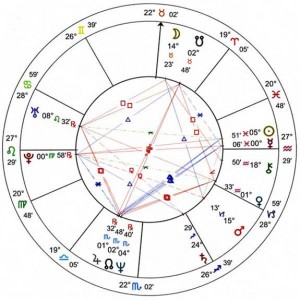Designing With the Cosmos
Posted on November 11, 2012 | posted by:“Astrology describes us as living in Kairos, or “fulcrum” moment. The future is not fixed (but it’s not broken, either). Our actions can tip the fulcrum either way, toward the life or death of innumerable communities of creatures living on this planet. By voting with our imaginations, we determine the outcome.” -Caroline Casey
I have yet to meet someone in the United States who doesn’t know their zodiac sun sign or at least have someone near them who does (if you happen to be that first someone nice to meet you). With enthusiasm or reluctance, astrology has traction. Syndicated columns across the globe attest to this, reflecting our persistent intrigue of this ancient, cosmic language. Unfortunately our mainstream understanding of astrology is so shrouded in superstition, we miss out on its true offerings: lessons in whole systems thinking.
Fundamentally astrology is a lesson in whole systems thinking, one that humans have been studying for a good 25,000 years (beginning with tracking lunar cycles). What is our relationship with these celestial bodies? How do they affect our life here? Is there life there? I can imagine these basic questions guiding our ancient ancestors’ inquiry into the radiant mass (think pre-light pollution) of stars, planets and comets performing a slow and sometimes, sudden dance overhead.
Our contextual grid of space and time is utterly dependent on our relationship with the other planets and stars in our solar system. The origins of clocks are mere mediations of our relationship with the sun. Add moon cycles to the mix and we begin to see the workings of a calendar. Time. Chronos. Indeed the cosmos provided the opportunity for our clocks to be born. Still, calculating chronos time doesn’t require astrology. The much less controversial and fully accredited scientific study of astronomy provides our numerical relationship with the cosmos. A sad fact I naively learned the first day of my astronomy class as a college freshman: astronomy consists of numbers and astrology consists of symbols. Put another way, astronomy tracks the cycles of time and astrology interprets them. Relying on astronomy though moving beyond its limits, astrology expands our sense of relationship, and hence systems.
Astrology 101 mini-lesson
A primary tool of astrology is the natal chart. The natal chart is a snap shot of the universe the moment a person is born. It requires the date, time and location of birth to be determined. Astrology is harmonic, with many layers of complication all working in dynamic relationship. For the sake of simplification, there are four primary thematic layers that illustrate the depth of whole systems thinking operating within the framework of Western astrology, they are: planets, signs, houses and aspects.
» People are most familiar with the zodiac signs (Aquarius, Sagittarius, Scorpio, etc). These signs refer to the constellations along the ecliptic, the path the sun appears to trace as seen from the earth. Since it takes 365 days for the earth to rotate the sun, likewise it takes 365 days for the sun to travel through the full spectrum of the ecliptic. This results in 12 zodiac signs, each of which occupy 30degrees of the ecliptic plane and approximately 30 days of the year.
» In astrology houses represent different spheres of experience in your life. For example, the 1st house signifies ego, personal identity; the 4th house represents ancestry, heritage; the 10th house is the sphere of career, work in the world. Like the zodiac signs there are also twelve houses. The ascendant sign determines the location of houses (the constellation at the Eastern horizon the moment of birth) nonetheless, they operate on their own cycle. In other words houses and signs are related but independent.
» Planets are self-explanatory and bring a third complication to the natal chart. Generally there are inner planets (the planets closer to the sun) such as Venus and Mercury, and outer planets (farther from the sun) such as Neptune and Neptune. The inner planets refer to our personal life as individuals and the outer planets refer to our collective lives as a society and species. Each of these planets not only travels at their own speed of rotation with themselves, but also around the sun.
» I like to think of aspects as the dynamics of a party. They function as the gossip column of your natal chart: Who showed up with each other? Who can’t stand being near each other? Who got into a fight? Aspects indicate the politics of relationship between planets in your natal chart. They are based on the degree of distance between one planet and another, ranging from harmonious and supportive to challenging and instigating.
With just a basic glimpse into the core themes of astrology we begin to see a complicated system of multiple variables. Having a working knowledge of astrology exercises our capacity to think in complexity, furthermore its personal. Remember the natal chart is a snap shot of the sky the moment you were born. Each of these themes is a different concept of measuring that moment – both quantitatively and qualitatively. While a sun sign may be accurate it is a gross simplification of an individuals cosmic profile, as well as a moment in time.
Astrology offers us unique vantage points: of space, time, relationships, complexity, patterns. Having a basic literacy of astrological factors enables an enhanced understanding of the context of each moment. As designers, this practice of scalar contextualizing becomes indispensible in designing sustainable solutions. Despite our planet existing as a mere speck of dust in the universe it is nonetheless embraced by a community of other specks, all continuing in a complexity of patterns and relationships. What better way to reassuringly design a new future?

